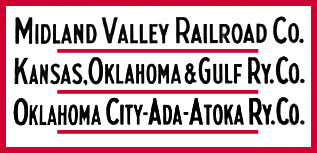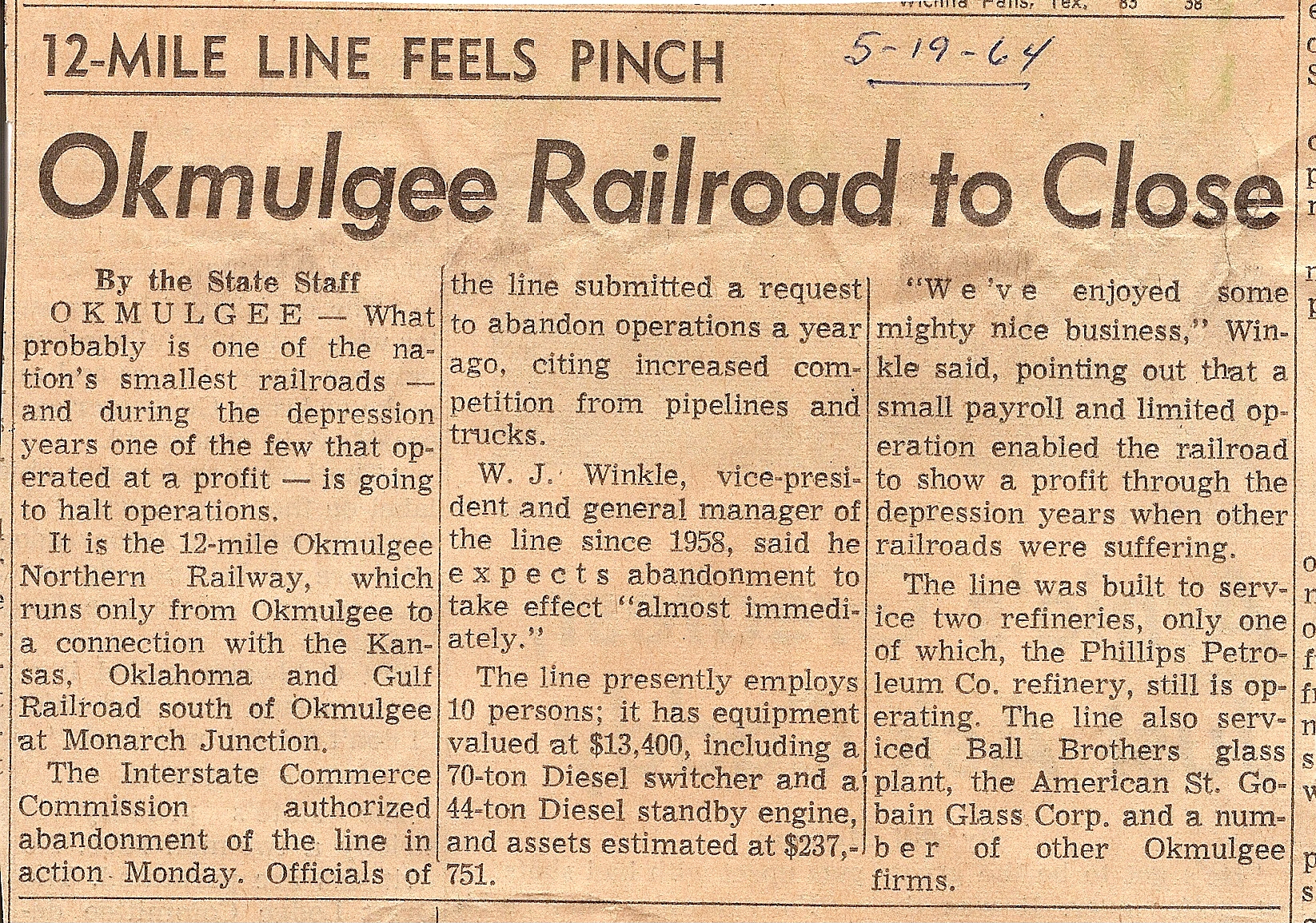 |
Historical Information
|
See Hal Miller's "Muskogee Roads: a four state empire" in Spring 2008 Classic Trains See David Ingles "Second Section" in Spring 2009 Classic Trains |
Trackage Rights on Frisco into Ft. Smith Contributed by John Dill Here is some Midland Valley information which gives the operating expenses for the joint track arrangement with Frisco from Maney Junction (Rock Island, IT) to Fort Smith. This information came from Ingersoll's private papers and includes the cost for sharing the Frisco station at Fort Smith. The total cost for 1908 to Midland Valley, for the joint track arrangement with Frisco into Fort Smith, was $13,049 for track rent; $750 use of Frisco's passenger station; $3,000 track maintenance and $2,100 station operating expense for a total of $18,899. (It is possible that MV may have later gotten this rate reduced a little as a document from 1911 gives the lease rate as $600 per mile.) In 1908 the Midland Valley was operating 6 trains per day over this leased Frisco track, except on Sunday when only one was operated. The average operating distance was about 16 miles from Maney Jct. (Rock Island, IT) to the Fort Smith, AR Frisco depot. It is sometimes confusing but needs to be remembered that this lease arrangement had nothing at all to do with the "Mansfield Branch" of the Frisco. MV crossed it twice with their own tracks but didn't operate trains over it. It is interesting to note that the part of the leased Frisco track south of Bonanza, AR had the Frisco, the Midland Valley, and the Missouri & Louisiana all operating over the same short stretch of rail at this time. (In fact, from what we have discovered some of the Missouri & Louisiana traffic continued on down the Frisco past Jenson, through Maney Jct. and all the way to Poteau, IT.) I have read comments in articles in the "Key" (South Seb. Historical Society) about how much rail traffic there was through Jenson in those years, but I'm just now starting to realize just how many trains that may have been. In August 1910 Frisco submitted a bill to MVRR for the cost of replacing the 60# rail on this shared track. This was a couple of years after the rail had been replaced. Frisco documents, submitted to MV, showed the 1886 rail which was removed from Maney Jct. (Rock Island, IT) to Jenson Jct. (the Arkansas line) had been laid new. The rail from Jenson to Fort Smith had previously been used. This rail had originally been first laid on the Bentonville Branch "for 3 or 4 years". The replacement rail was 75#. I don't have all the answers but at least I can now offer some documentation for my theory about who named it. or at least took credit. In court testimony after the 1914 mine riots, (FINLEY, RECEIVER, ET AL. VS. p. 1386) Franklin Bache made the following statement: (about the Choctaw) "I was asked to locate their Ardmore branch that runs from Haileyville down to Ardmore, to get the road on the outcrop of the coal, so it would be able to get the coal traffic. Then about that time, 1902, the C.O.& G. was sold, lock, stock and barrel, everything to the Chicago, Rock Island & Pacific Railway, and all of our operating contracts were sold to the same interest. The Midland Valley people, those who became the Midland Valley people, were stockholders in the old C.O.& G. and got quite a bit of money out of the sale to the Rock Island, and decided to build another road to develop coal, and asked me to take charge, as far as the coal fields were concerned. It then became the Midland Valley, and they wanted the line near the outcrop of the coal, so the railroad could get the tonnage easily. I did that for them, and also bought for them several thousand acres of land in Sebastian County, and a little over in Oklahoma for about - I don't know how much, seven or eight hundred thousand dollars, perhaps a million dollars, the whole thing cost." "Along about the same time I bought some land where the Mammoth Vein No. 1 is located, about 200 acres in that purchase, and about 400 acres of land where the town of Midland is now. It was a farm then, and I started the town of Midland, sold lots, and intended to open that mine there, and in fact started." This all agrees with other sources I had seen. Bache started the town of Midland as a private speculation for himself and his partners, not as a part of the Midland Valley R.R. or for its principle owners. (Of course he was also a Midland Valley stockholder). This took place as/after the Midland Valley was being built and he no doubt named it for the railroad. Of course this throws no light on the origin of the railroad's name - but you can bet it was picked by the same bunch in Philadelphia that had owned the Choctaw and later the Midland Valley. |
Abandoned lines around Wagoner, OK
Question on Rail Spot by Ashley Harris Answer by John Fike "The older is the original MO&G alignment circa 1912-13 that was relocated in the early 50s during the construction of the Fort Gibson reservoir. The newer (the more northerly of the two) is the relocated line." "Robert Lomax, the last president of the Muskogee Company railroads, told me that they had tried to persuade the Corps of Engineers to relocate them to the West side of the Grand River, because the Markham Ferry dam was already planned, and that would have resulted in yet another relocation that would cause the abandonment of much of the Ft. Gibson relocation. The Corps refused." "Since the "Powder Plant" (Oklahoma Ordnance Works) south of Pryor was mothballed at the time, the Katy would have perhaps had little objection to the KO&G being moved to the West, across the river. Had that happened, the KO&G north of Wagoner might not have been ultimately sold to the GRDA and abandoned." "The Pryor Industrial park was later sold to the state and became the Katy's largest traffic source in Oklahoma, according to Mr. Lomax. That caused the Katy to block the proposal to move the KO&G when the Markham Ferry reservoir was built in the 1960s." |

Related web sites:
MPHS
OCAA web site
This site is maintained by the Arkansas Boston Mountains Chapter of the National Railway Historical Society located in Springdale, Arkansas
Home of THE ARKANSAS SCRAMBLER
For questions, email arkyrail at outlook.com